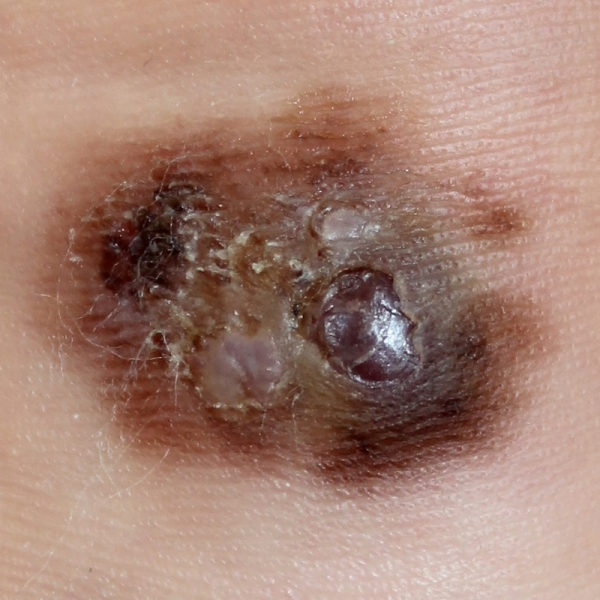
What is black skin cancer?
Malignant melanoma is also colloquially called black skin cancer. It is a malignant tumour that mainly affects the skin. The incidence of black skin cancer is increasing every year because the introduction of skin cancer screening has made it possible to diagnose the disease much earlier. About two thirds of all melanomas can be detected early and surgically removed. The patient then has good prospects of a cure. In general, the 5-year survival rate for women is 93 percent, while it is 91 percent for men.
On average, women are diagnosed with malignant melanoma at the age of 67, while men are affected more frequently than average at around 60. Black skin cancer is the fifth most common type of tumour in men and the fourth most common in women. If black skin cancer is detected early, it can be surgically removed.
What factors cause black skin cancer?
Black skin cancer is caused by the pigment-forming skin cells (melanocytes) or the mucous membrane. Above all, strong and recurring UV radiation, especially in childhood and adolescence, plays a role in this. Increased pigment moles can develop even without sunburn, which is why regular sunbathing, for example frequent visits to tanning salons, increases the risk of skin cancer by at least 75 percent. Other factors that increase the likelihood of skin cancer are:
- hundreds or more normal-looking moles,
- five or more noticeable moles with fifty or more normal-looking moles (atypical nevus syndrome),
- five or more conspicuous moles and at least two first-degree relatives who have already had black skin cancer.
In addition, the genetic predisposition to the development of malignant melanoma is not insignificant. Especially people with light skin (skin types I and II), reddish or blond hair, freckles and sunburn spots, as well as relatives who have already had black skin cancer, have up to 120 times the risk of developing this type of cancer.
How does black skin cancer manifest itself?
The various forms of black skin cancer differ from each other externally. In most cases, however, black skin cancer appears as a dark or black spot. In some cases, it can also be a spot with different shades of grey to blue, which can appear either flat, raised or nodular. While some melanomas cause little discomfort, other melanomas can cause itching or bleeding. A mucosal melanoma can make itself felt by bleeding from the nose. In any case, conspicuous skin changes should be clarified by a dermatologist.
What types of malignant melanoma are distinguished?
- Superficial spreading melanoma: is with 60 percent the most frequently occurring malignant melanoma, which mainly occurs on the back, chest, arms and legs. It spreads over a longer period of time before it then grows relatively quickly into the depths.
- Nodular melanoma: affects only about 5 per cent of all malignant melanomas and is characterised by its brown to blue-black nodules, which can sometimes take on a red hue, are always smooth and wart-like or broken up (ulcerated) and bleed easily and immediately grow rapidly in depth. They occur predominantly on the back, chest, arms or legs.
- Lentigo maligna melanoma: usually grow slowly over several years, especially in areas that are frequently exposed to light, such as the head. They are characterised by their light to dark brown or white to blue-grey colour and flat appearance. They are particularly common in older people.
- Acral lentiginous melanoma: is the rarest, occurring in about 4 per cent of cases, and is mainly found on the "acras", i.e. the fingers and toes, but also on the soles of the feet, the palms of the hands and the nail bed.
- Mucosal melanoma: very rarely occurs in the mucous membranes and can affect the oral and genital mucous membranes, but also the paranasal sinuses. This type of malignant melanoma has a rather poor prognosis.
How is black skin cancer diagnosed?
First, the doctor will ask about any noticeable skin changes or cases of skin cancer in your circle of relatives. Then the skin is carefully examined for spots and other abnormalities. In the case of suspicious skin areas, reflected-light microscopy is used. Here, a highly magnified magnifying glass including a lamp is held up to the surface of the skin, thus making it possible to detect tumours at an early stage. For a confirmed diagnosis, the doctor takes tissue and analyses it under the microscope (biopsy). If the tumour has reached a thickness of 1 mm, the probability increases that the neighbouring lymph nodes are also affected. Therefore, these should also be examined under the microscope (sentinel lymph node biopsy).
How is black skin cancer treated?
If black skin cancer is diagnosed early, the doctor will usually try to remove it completely by surgery. This depends, among other things, on the tumour thickness, i.e. the stage of the cancer. In particular, melanomas that have grown thinly on the surface of the skin have the best chance of being completely cured by surgery. If, on the other hand, the tumour has already penetrated the second layer of skin (dermis), the probability of metastasis increases. If the tumour has already metastasised in the body, treatment is more difficult. In this case, the patient's chances of recovery also decrease. However, medicine has developed considerably in this regard in recent years. In order to destroy the individual tumour cells that have already spread throughout the body, supportive, so-called adjuvant treatment options are used. Adjuvant therapies are also used to significantly reduce the risk of recurrence.
Adjuvant therapies include radiotherapy and/or medication. Which therapy is used in each case depends, for example, on the possible side effects, but also on whether mutations were found in the tumour.
